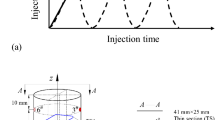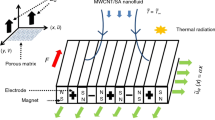Abstract
In this study, two modifications are proposed to mitigate drawbacks of the conventional approach of using the “Porous Media Model” (PMM) for nuclear reactor analysis. In the conventional approach, whole reactor core simplifies to a single porous medium and also, the resistance coefficients that are essential to using this model are constant values. These conditions impose significant errors and restrict the applications of the model for many cases, including accident analysis. In this article, the procedures for calculating the coefficients are modified by introducing a practical algorithm. Using this algorithm will result in obtaining each coefficient as a function of mass flow rate. Furthermore, the method of applying these coefficients to the reactor core is modified by dividing the core into several porous media instead of one. In this method, each porous medium comprises a single fuel assembly. PMM with these two modifications is termed “multi-region PMM” in this study. Then, the multi-region PMM is introduced to a new CFD-based thermo-hydraulic code that is specifically devised for combining with neutronic codes. The CITVAP code, which solves multi-group diffusion equations, is the selected as the neutronic part for this study. The resulting coupled code is used for simulation of natural circulation in a MTR. A new semi-analytic method, based on steady-state CFD analysis is developed to verify the results of this case. Results demonstrate considerable improvement, compared to the conventional approach.























Similar content being viewed by others
Abbreviations
- PMM:
-
Porous media model
- CFD:
-
Computational fluid dynamics
- MTR:
-
Material test reactor
- FA:
-
Fuel assembly
- RANS:
-
Reynolds-averaged Navier-Stokes
- TRR:
-
Tehran Research Reactor
- SAR:
-
Safety analysis report
- φ :
-
Porosity
- ρ :
-
Density
- D:
-
Viscous resistance coefficient
- C:
-
Inertial resistance coefficient
- μ :
-
Viscosity
- k :
-
Coefficient of thermal conductivity
- c p :
-
Specific heat capacity at constant pressure
- V :
-
Volume of porous medium
- L :
-
Length of porous medium along the axis of FA
- v :
-
Velocity
- h :
-
Specific enthalpy
- Pr t :
-
Turbulent Prandtl Number
- P :
-
Pressure
- T :
-
Temperature
- (τ ij )app :
-
Apparent stress tensor
- β :
-
Thermal expansion coefficient
- H :
-
Active Height (Length) of fuel plates
- f:
-
Fluid
- s:
-
Solid
- a or z :
-
Average along the axis of FA (z-axis)
- E:
-
Equilibrium (steady) state of natural convection
References
H. Darcy, Les Fontaines Publiques de la Ville de Dijon (Dalmont, Paris, 1856)
S. Ergun, Fluid flow through packed columns. Chem. Eng. Prog. 48, 89–94 (1952)
A. Khaled, K. Vafai, The role of porous media in modeling flow and heat transfer in biological tissues. Int. J. Heat Mass Transf. 46, 4989–5003 (2003). doi:10.1016/S0017-9310(03)00301-6
Z. Chen, G. Huan, Y. Ma, Computational Methods for Multiphase Flows in Porous Media (Society for Industrial and Applied Mathematics (SIAM), Dallas, 2006)
O. Zienkiewicz, R. Taylor, J. Zhu, The Finite Element Method for Fluid Dynamics, 6th edn. (Elsevier, New York, 2005)
R. Lewis, B. Schrefler, The Finite Element Method in the Deformation and Consolidation of Porous Media (Wiley, Chichester, 1998)
D. Nield, A. Bejan, Convection in Porous Media (Springer, New York, 1992)
M. Kaviany, Principles of Heat Transfer in Porous Media (Springer, New York, 1991)
C. Hsu, P. Cheng, Thermal dispersion in a porous medium. Int. J. Heat Mass Transf. 33(8), 1587–1597 (1990). doi:10.1016/0017-9310(90)90015-M
B. Antohe, J. Lage, A general two-equation macroscopic turbulence model for incompressible flow in porous media. Int. J. Heat Mass Transf. 40(13), 3013–3024 (1997). doi:10.1016/S0017-9310(96)00370-5
S. Nasrallah, P. Perre, Detailed study of a model of heat and mass transfer during convective drying of porous media. Int. J. Heat Mass Transf. 31(5), 957–967 (1988). doi:10.1016/0017-9310(88)90084-1
Y. Yan, Development of a Coupled CFD System-code Capability & its Applications to Simulate Current & Next Generation Reactors. PhD thesis. University of Illinois at Urbana-Champaign, Illinois (USA) (2011)
Y. Yan, R. Rizwan-uddin, CFD Simulation of a Research Reactor. in Proceedings of the American Nuclear Society Topical Meeting in Mathematics & Computations. Avignon, France (2005)
S.B. Pope, Turbulent Flows (Cambridge University Press, Cambridge, 2000)
J. Duderstadt, J. Hamilton, Nuclear Reactor Analysis (Wiley, New York, 1976)
S.V. Patankar, Numerical Heat Transfer and Fluid Flow (Hemisphere, Washington, 1980)
R.J. Leveque, Finite Volume Methods for Hyperbolic Problems (Cambridge University Press, Cambridge, 2004)
A.J. Chorin, Numerical solution of Navier–Stokes equations. Mathematics of Computation 22, 745–762 (1968). doi:10.1090/S0025-5718-1968-0242392-2
B. Launder, D. Spalding, Lectures in Mathematical Models of Turbulence (Academic Press, London, 1972)
T.H. Shih, W.W. Liou, A. Shabbir et al., A new k − ε eddy-viscosity model for high Reynolds Number turbulent flows—model development and validation. Computers Fluids 24, 227–238 (1995). doi:10.1016/0045-7930(94)00032-T
C. Chen, V. Patel, Near-wall turbulence models for complex flows including separation. AIAA J. 26, 641–648 (1988). doi:10.2514/3.9948
T. Barth, D. Jespersen, The design and application of upwind schemes on unstructured meshes. Technical Report AIAA-89-0366. AIAA 27th Aerospace Sciences Meeting, Reno, Nevada (USA) (1989)
B.P. Leonard, The ULTIMATE conservative difference scheme applied to unsteady one-dimensional advection. Comp. Methods Appl. Mech. Eng. 88, 17–74 (1991). doi:10.1016/0045-7825(91)90232-U
W. Anderson, D. Bonhus, An implicit upwind algorithm for computing turbulent flows on unstructured grids. Computers Fluids 23(1), 1–21 (1994). doi:10.1016/0045-7930(94)90023-X
Z.J. Wang, A fast nested multi-grid viscous flow solver for adaptive cartesian/quad grids. Int. J. Numer. Methods Fluids 33, 657–680 (2000). doi:10.1002/1097-0363(20000715)33:5<657:AID-FLD24>3.0.CO;2-G
C. Rhie, W. Chow, Numerical study of the turbulent flow past an airfoil with trailing edge separation. AIAA J. 21(11), 1525–1532 (1983). doi:10.2514/3.8284
R.I. Issa, Solution of implicitly discretized fluid flow equations by operator splitting. J. Comput. Phys. 62, 40–65 (1986). doi:10.1016/0021-9991(86)90099-9
B. Hutchinson, G. Raithby, A multi-grid method based on the additive correction strategy. Numer. Heat Transf. 9, 511–537 (1986). doi:10.1080/10407788608913491
W. Press et al., Numerical Recipes in C (Cambridge University Press, Cambridge, 1992)
ANSYS, Inc. ANSYS Fluid Dynamics Verification Manual. Canonsburg, Pennsylvania (USA), November, 2013
J.W. Baughn, M.A. Hoffman, R.K. Takahashi et al., Local heat transfer downstream of an abrupt expansion in a circular channel with constant wall heat flux. J. Heat Transf. 106, 789–796 (1984). doi:10.1115/1.3246753
T. Kuehn, R. Goldstein, An experimental study of natural convection heat transfer in concentric and eccentric horizontal cylindrical annuli. J. Heat Transf. 100, 635–640 (1978). doi:10.1115/1.3450869
F. Incropera, D. Dewitt, Fundamentals of Heat and Mass Transfer, 5th edn. (Wiley, New York, 2006), p. 117
E. Villarino, A.L. Carlos, CITVAP v.3.1 Reactor Calculation Code, MTR_PC Package. Nuclear Engineering Division, INVAP, Argentina (1993)
NEA.WIMSD-5B. A Neutronic Code for Standard Lattice Physics Analysis (2003)
AEOI, Safety Analysis Report for the Tehran Research Reactor (LEU). Tehran, Iran, 2001
IAEA, IAEA-TECDOC-949. Thermo-physical properties of materials for water cooled reactors. International Atomic Energy Agency, Vienna, Austria (1997)
N.E. Todreas, M.S. Kazimi, Nuclear systems II, elements of thermal hydraulic design (Hemisphere Publishing Corporation, New York, 2001)
I.H. Shames, Mechanics of Fluids, 4th edn. (MacGraw-Hills, New York, 2002)
Acknowledgments
The authors are gratefully indebted to Nuclear Science and Technology Research Institute (NSTRI) of Atomic Energy Organization of IRAN (AEOI) for providing some of the basic data required for this study. However, all funding of this study has been provided by the authors.
Author information
Authors and Affiliations
Corresponding author
Rights and permissions
About this article
Cite this article
Vadi, R., Sepanloo, K. An improved porous media model for nuclear reactor analysis. NUCL SCI TECH 27, 24 (2016). https://doi.org/10.1007/s41365-016-0016-7
Received:
Revised:
Accepted:
Published:
DOI: https://doi.org/10.1007/s41365-016-0016-7




